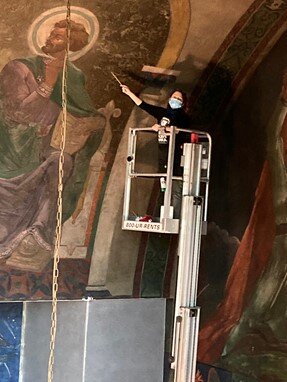Rikke Foulke, ACE Senior Painting Conservator
Conservator, Rhonda Wozniak, touches the ceiling murals in Saint Nicholas Croatian Catholic Church, painted by Maxo Vanka in 1937-41.
Through the efforts of the Society to Preserve the Millvale Murals of Maxo Vanka and funding the Pennsylvania Historical and Museum Commission Keystone Planning Grant and the Heinz Endowments, Art Conservation Etc. (ACE) conservators will complete a survey of the upper murals at St. Nicholas Croatian Catholic Church in Millvale, PA. The upper murals cover approximately 2,740 square feet. The ceiling murals max out at a height of approximately 38ft, which requires a hydraulic lift for their examination.
The murals are heavily soiled with post-industrial age soot and dust. The paint layers also exhibit scattered areas of loss due to salt formation on the surface of the plaster beneath. Salt formation, or efflorescence, occurs as a result of moisture moving through the plaster substrate, forming salts on the surface as it evaporates.
One goal of the survey is to perform cleaning tests on various sections of the murals. This small lamb (below) is in the lower right corner of the New Testament mural in the southern transept.
The lamb appears dull and dirty due to the decades of deposits on the surface. The surface is initially dusted prior to cleaning and a LOT of dust lifts easily! The images below feature the lamb before treatment (left), after treatment (center), and samples of cleaning swabs (right).
Rikke Foulke, Lead Conservator, taking a closer look at the gilded background of Luke.
Led by Rikke Foulke, ACE Senior Paintings Conservator, all of the murals in the lower registers and entry were previously conserved by ACE intermittently over the past nine years. Team members consist of local professionally trained conservators: Ana Alba, Patricia Buss, Cynthia Fiorini, Patty West, and Rhonda Wozniak.
Rikke’s team has a diverse background with each member contributing skills from their area of specialization. Rikke has worked in museums all over the world, including the the Lenbachhaus in Munich, Germany and the National Gallery of Art in Washington, D.C. She has also published research on the effect of nanoparticles on the stabilization of the plaster walls of the murals in several publications: "Nanoparticles for stabilization of salts in St. Nicholas Church, Pittsburgh, Pennsylvania." AIC Paintings Specialty Group Postprints. Vol. 25 2013. Indianapolis, IN. and "Nanoparticles for stabilization of salts in St. Nicholas Church, Pittsburgh, Pennsylvania." Salt Weathering on Buildings and Stone Sculptures. I. Ioannou and M. Theodoridou, eds. Limassol: University of Cyprus, 2011. 275 – 282. Print.
Her work reducing the salts and stabilizing the plaster with nanoparticles will continue in areas of the Old Testament mural post survey when Phase II of the conservation efforts are underway.
A packet of the aluminum leaf found in Maxo Vanka’s studio
Patty West, ACE Senior Objects Conservator, who has a considerable amount of experience on oil and water gilding/leafing, has identified Vanka’s application of leaf in the backgrounds of Matthew, Mark, Luke and John, as oil-based. Fortunately, the oil preparation results in a durable surface. The conservators hope to apply XRF analysis to confirm the identity of the leaf as aluminum. Supporting evidence was found by the granddaughter of Maxo, Marya Halderman, when she discovered several packets of aluminum foil in the artist’s studio.
The Team also includes: Ana Alba, ACE Paintings Conservator; Patty Buss, Paintings Conservator; and Rhonda Wozniak, ACE Senior Objects Conservator .
ACE Paintings Conservator, Ana Alba, performs cleaning tests on murals in the choir loft.
Ana Alba has extensive experience with modern materials and newly developed cleaning methods. She expertly applies her skills to finding a safe solution to work with these fragile surfaces.
Patty Buss, inpainting guru, and true artisan, brings mural conservation experience from her years at the Conservatorio di Santa Maria degli Angiolini. She applies her pastel palette judiciously in areas of loss to make them magically disappear.
Rhonda Wozniak is comfortable at heights, and fearlessly leads the way up with the lift to access the ceiling, as seen in the image at the top of this blog. Also, through Rhonda's contacts in researching metal artifacts, she has introduced an analytical team which will carry out XRF and other analytic techniques on some of the materials used in the murals.
Our experienced conservators have been trusted with the preservation of valuable works of art in museums both locally, and throughout the world. ACE Conservators are excited to bring their talents together to find the best solutions to preserve local Pittsburgh treasures, such as the amazing murals of Maxo Vanka.
Special thanks goes to the Society to Preserve the Millvale Murals of Maxo Vanka, who since 2009 have raised more than one million dollars for the lighting and ongoing preservation of the murals. Many thanks to Pennsylvania Historical and Museum Commission Keystone Planning Grant and Heinz Endowments for their generous support of this project.
To support to the ongoing fundraising campaign for this project or to schedule a docent-guided tour, please visit the SPMMMV website: vankamurals.org/donate or click on the button below.


































